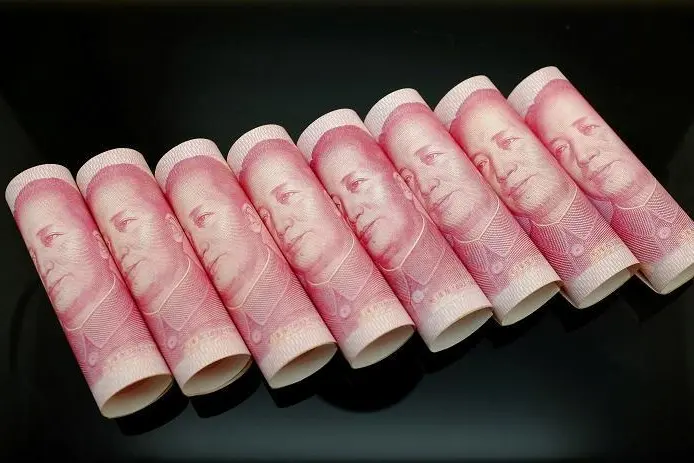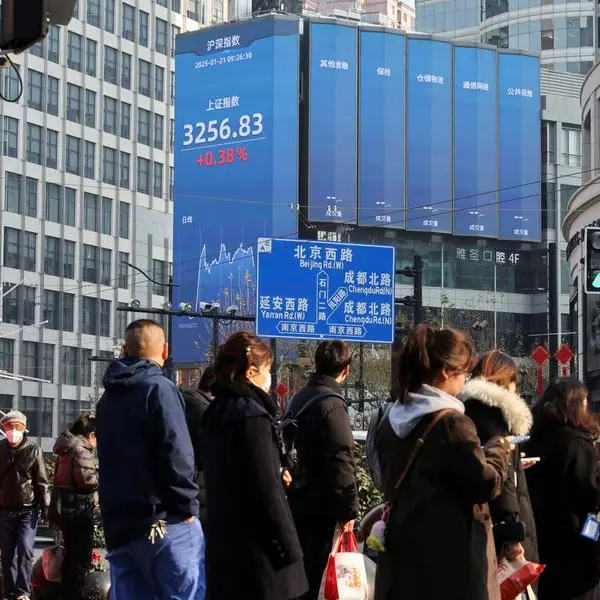PHOTO
100 Yuan notes are seen in this illustration picture in Beijing, China November 5, 2013. Jason Lee, Reuters Image for illustrative purpose.
China's onshore yuan extended losses on Wednesday to end the domestic session at its lowest level against the dollar since the global financial crisis of 2008, while the offshore yuan hit a record low, pressured by expectations of more U.S. rate hikes.
Currency traders said the yuan was reacting to broad greenback strength in global markets as the dollar hit a fresh two-decade peak against a basket of currencies, buoyed by safe-haven demand and a hawkish Federal Reserve.
In onshore markets, the yuan finished the domestic trading session at 7.2458 per dollar, its weakest such close since January 2008 and down 658 pips or 0.91% from previous late night close of 7.18.
The offshore yuan followed suit and weakened 1.15% on the day to trade at 7.2635 around 0830 GMT.
Several currency traders said corporate dollar buying was very strong on Wednesday, piling additional pressure on the yuan.
"Those who want to convert their FX receipts into yuan are holding back and waiting for better prices," said a trader at a foreign bank.
A second trader at a foreign bank said the weakness in the yuan was in line with other currencies on Wednesday.
"Non-dollar currencies all crashed in early trades, the yuan can't escape," said the trader.
Prior to the market opening, the People's Bank of China (PBOC) set the midpoint rate at 7.1107 per dollar, the lowest level in over two years, and 385 pips or 0.54% weaker than the previous fix of 7.0722.
The daily midpoint fixing limits onshore trade to a narrow range of 2% on either side, and Thursday's guidance kept the range to between 6.9685 and 7.2529. The domestic closing price was 71 pips from the weaker end of the downside limit.
"The authorities have been seeking to slow the pace of depreciation through setting much stronger than expected fixings, but it is clear that there is no particular level that they are seeking to defend," analysts at ANZ said in a note.
"Hence, in the face of further dollar strength, the authorities will ultimately allow the yuan to weaken further but will act to ensure any move is not disorderly."
The declines come even as China's central bank on Monday announced fresh steps to slow the pace of the yuan's recent fall by making it more expensive to bet against the currency.
Earlier this month, the PBOC also cut the amount of foreign exchange reserves that financial institutions must hold in a move also seen as aimed at slowing the yuan's depreciation.
Efforts by authorities to stem yuan weakness were having a limited impact, said a third trader at a Chinese bank.
Unlike most other central banks which are rapidly tightening policy to tackle soaring inflation, the PBOC has been easing its settings to support the sputtering Chinese economy.
A source told Reuters late on Tuesday that Chinese monetary authorities are asking local banks to revive a yuan fixing tool it abandoned two years ago as they seek to steer and defend the rapidly weakening currency.
"We believe the CNY fixing guidance will remain the primary tool to support the RMB and, if necessary, the PBOC will freeze the CNY fixing to lock the USD/CNY spot at the 2% upper trading limit," said Ken Cheung, chief Asian FX strategist at Mizuho Bank.
"This will prove to be the least costly but effective policy to cap the USD/CNY spot," Cheung said.
He expects the authorities could take more action including verbal messages, often known as "window guidance", to slow the pace of yuan depreciation. (Reporting by Winni Zhou and Brenda Goh; Editing by Ana Nicolaci da Costa and Kim Coghill)





















